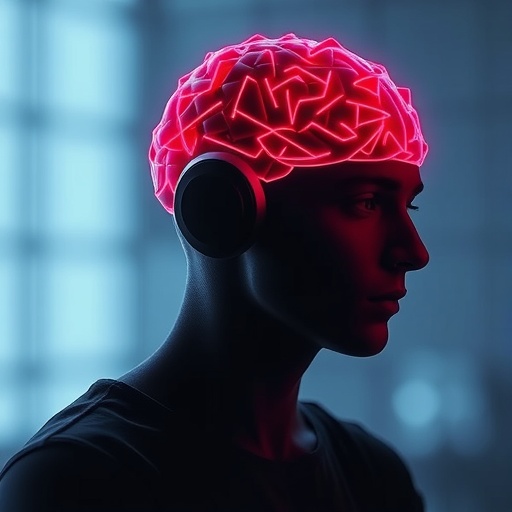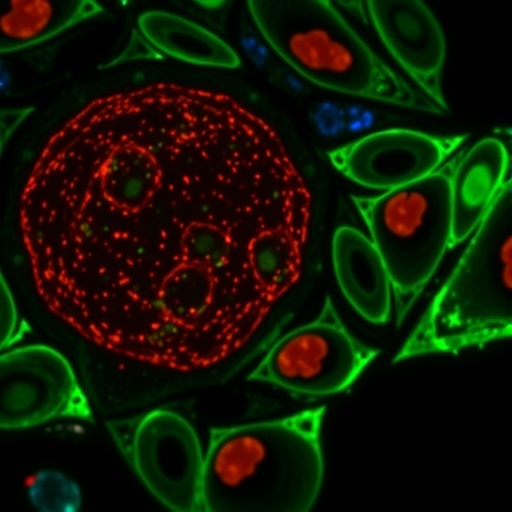In an era where digital engagement dominates daily life, the shadow of Internet Gaming Disorder (IGD) looms large, affecting millions worldwide. This behavioral addiction, characterized by excessive and compulsive gaming, has significant psychological and neurological consequences. Especially intriguing is the intersection of IGD with social anxiety, a condition that exacerbates the vulnerability of individuals to this digital compulsion. Recent advancements in neuroscience and artificial intelligence offer promising avenues to untangle this complex relationship. A groundbreaking study by Yeh, Lin, Sun, and colleagues dives deep into the neural substrates of individuals at high risk of IGD who also suffer from social anxiety, leveraging state-of-the-art EEG-based machine learning techniques to decipher intricate brain dynamics.
Electroencephalography (EEG), a non-invasive method that measures electrical activity in the brain, serves as the cornerstone of this research. Unlike traditional diagnostic tools, EEG offers real-time insights into neurophysiological processes, capturing the brain’s oscillatory behavior across various frequency bands. The study transcends conventional analysis by integrating time–frequency dynamics with advanced brain connectivity measures, painting a detailed picture of how neural circuits operate differently under the confluence of IGD and social anxiety.
At the heart of the investigation lies the application of machine learning algorithms to EEG data, a methodological leap that enables the identification of subtle neural patterns unobservable through classical statistical methods. By training computational models on the EEG signals, the researchers extracted distinguishing features that characterize the neural underpinnings of high-risk individuals. This paradigm shift toward data-driven neuroscience highlights the potential for machine learning to revolutionize mental health diagnostics by enhancing accuracy and predictive capabilities.
The utilization of time–frequency analysis is critical in this context, as it accounts for how power in different EEG frequency bands evolves over time. Brain oscillations spanning delta, theta, alpha, beta, and gamma bands have all been implicated in various cognitive and emotional functions. Through meticulous decomposition of EEG signals, the study reveals unique oscillatory signatures associated with social anxiety and IGD comorbidity, implicating altered neural synchronization and regulation mechanisms.
Moreover, brain connectivity analysis unearths the communication patterns between distinct neural regions. Functional connectivity measures inform how regions synchronize their activity, shedding light on network-level dysfunctions that underlie complex behaviors like addictive gaming. By mapping connectivity alterations, the research exposes disrupted pathways potentially responsible for impaired self-control and heightened anxiety, both hallmark features of IGD intertwined with social anxiety.
One of the most compelling findings pertains to the interaction between frontal and limbic areas. These regions play pivotal roles in executive functioning and emotional regulation, respectively. The study documents attenuated connections in this circuitry, suggesting a diminished capacity to modulate gaming impulses and social fears. This neural decoupling frames the clinical presentation seen in individuals prone to IGD, offering a neurobiological explanation for the observed behavioral symptoms.
In addition to cross-sectional insights, the EEG-machine learning framework holds promise for longitudinal monitoring of IGD progression and therapeutic outcomes. By capturing dynamic changes in brain connectivity and oscillations, clinicians can track the effectiveness of interventions with unprecedented granularity. This approach may herald a new era of personalized mental health care, fostering early detection and customized treatment protocols for those affected.
The implications extend beyond IGD and social anxiety, positioning EEG-based machine learning as a versatile tool in psychiatry and behavioral neuroscience. The ability to decode real-time neural mechanisms underlying an array of disorders could reshape diagnostic criteria and therapeutic strategies across various domains, including depression, substance abuse, and other impulse control disorders.
Furthermore, the integration of time–frequency and brain connectivity analyses provides a multifaceted picture, bridging the gap between micro-level neural oscillations and macro-level brain networks. This holistic perspective enhances the understanding of the neural architecture governing complex behaviors, emphasizing the need for multi-dimensional research models in unraveling brain-behavior relationships.
The technical sophistication of the study is underscored by the meticulous preprocessing and feature extraction protocols employed in EEG data analysis. Noise reduction, artifact removal, and spectral decomposition methods ensure that the extracted features truly reflect underlying neural processes rather than extraneous interferences. This rigorous data pipeline bolsters the reliability and validity of the machine learning models’ outputs.
Another highlight is the selection and tuning of machine learning classifiers. The researchers evaluated multiple algorithms, optimizing parameters to maximize classification accuracy between high-risk and control groups. This comparative approach underscores the importance of algorithmic choice in neuroscientific applications, where model interpretability and performance must be balanced to derive meaningful conclusions.
Ethical considerations also emerge as an integral facet of this research landscape. Given the sensitive nature of brain data and the potential for stigmatization of individuals with IGD and social anxiety, the study adheres to stringent privacy and consent protocols. Moreover, the authors advocate for responsible deployment of AI in mental health, emphasizing that technology should augment rather than replace human clinical judgment.
The societal relevance of this research cannot be overstated. As global gaming trends continue to surge, understanding the neuropsychological risks associated with excessive gaming becomes paramount. This study charts a path forward, where objective neurobiological markers guide public health policies and educational programs aimed at mitigating gaming addiction and its psychological fallout.
In essence, Yeh, Lin, Sun, and colleagues’ work stands at the vanguard of a neuroscience revolution, melding EEG technology, machine learning, and connectivity science to decode the brain’s labyrinthine responses to IGD intertwined with social anxiety. Their findings illuminate the neural signatures that predispose and perpetuate these conditions, forging new frontiers in diagnosis, monitoring, and intervention.
Future research inspired by this foundational study will likely explore larger and more diverse populations, integrate multimodal imaging techniques, and refine machine learning models to enhance their generalizability. The ultimate goal is to develop comprehensive neural profiles that capture the complexity of behavioral addictions, fostering holistic approaches to mental well-being in the digital age.
As the boundaries between artificial intelligence and neuroscience continue to blur, studies like this exemplify the transformative potential of technology to unravel the enigmas of the human mind. The journey toward understanding and ameliorating Internet Gaming Disorder and social anxiety is poised for profound advancements, driven by innovative approaches that harness the full spectrum of brain activity.
The integration of these findings into clinical practice promises a new paradigm in mental health care—one where biometric data and artificial intelligence collaboratively inform personalized interventions, promoting resilience and recovery for those grappling with the challenges of digital addiction and social anxiety.
The marriage of EEG-based machine learning with brain connectivity analysis marks a pivotal step in addressing the complex neurobehavioral dynamics underlying co-occurring Internet Gaming Disorder and social anxiety. It opens avenues not only for scientific discovery but also for real-world impact, fundamentally reshaping how society perceives, diagnoses, and treats these prevalent modern afflictions.
Subject of Research: Neural mechanisms and brain connectivity in individuals at high risk of Internet Gaming Disorder with social anxiety, analyzed through EEG-based machine learning.
Article Title: Application of EEG-Based Machine Learning in Time–Frequency and Brain Connectivity Analysis Among Individuals at High Risk of Internet Gaming Disorder with Social Anxiety.
Article References:
Yeh, PY., Lin, CL., Sun, CK. et al. Application of EEG-Based Machine Learning in Time–Frequency and Brain Connectivity Analysis Among Individuals at High Risk of Internet Gaming Disorder with Social Anxiety. Int J Ment Health Addiction (2025). https://doi.org/10.1007/s11469-025-01560-9
Image Credits: AI Generated
Tags: advancements in neuroscience and AIbehavioral addiction to online gamesbrain connectivity measuresdigital compulsion and mental healthEEG-based machine learning techniquesexcessive gaming risksinternet gaming disordermachine learning in neuroscienceneurological consequences of gamingneurophysiological processes in gamingsocial anxiety and gaming addictiontime-frequency dynamics in EEG





